DO IT YOURSELF
Drilling
Brickwork | Drilling Stonework | Apply
the Silicone | Planning | Summary
DIY Price
List | Application
Rates
Building professionals and heritage preservation authorities
recommend using a silicone damp-course for restoration
work because it is convenient, inexpensive, highly effective to
stop rising damp and it preserves the original wall materials.
With Ab-Tech Damp Proofing Liquid and expert advice, you
can do the work yourself and save money.
DRILLING & PREPARATION
The first stage of the treatment is drilling the holes to
allow distribution of the Ab-Tech damp-course material into the
wall.
For external walls, choose a horizontal mortar course or a notional
line, about 100-300mm above the footing or adjacent paths or ground
as the guideline to start the holes. For internal walls, start
drilling just above the skirting boards or alternatively, the
skirtings can be removed and the holes started from just above
floor level. Please ask for advice if you are unsure about the
correct location of the new damp-course for your job.
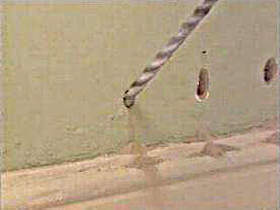
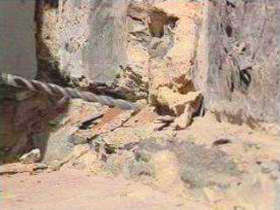
- Space the holes at about 75 to 100mm apart along the
chosen guideline. Drill downwards at an angle, to create a reservoir
to hold the damp-proofing liquid while it soaks into the wall.
The bottom of the hole should be at about the level that you
want the damp-course.
- Nominally 12mm diameter drill bit, but any size is
acceptable. The larger the hole, the quicker the liquid will
be absorbed. See some specific recommendations following.
- Vacuum clean all the dust after drilling, particularly
out of the holes. This avoids clogging the pores and helps speed
up absorption of the liquid.

DRILLING BRICKWORK
- For solid bricks, drill the holes at a steep angle,
from 45 degrees to 70 degrees, through one or two layers of bricks,
to end at a mortar course near the bottom of the wall. Drill
the holes at least half-way through of the thickness of the wall
skin, but take care to not drill completely through, otherwise
the injection liquid will run out and not be applied effectively.
- In exposed brickwork, start the drilling in a mortar
course, because it is easier to repair the mortar afterwards,
to hide the hole. Use 8mm or 12mm drill bits in solid exposed
brickwork.
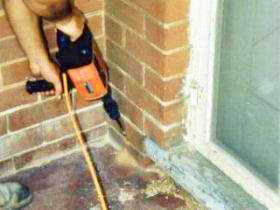
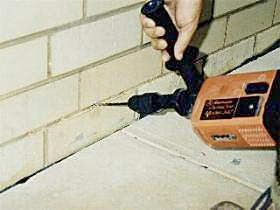
- Modern bricks or blocks have moulded hollows in the centre.
Drill through the mortar at a shallow angle and use the hollows
as a reservoir for dispersing the silicone liquid during the
soaking process. Use a 6mm to 10mm drill bit.
- In double brick cavity walls, each skin must be treated
separately, each the same as the single skin techniques, outlined
above. Ab-Tech Liquid should also be applied to the cavity to
soak the debris that has accumulated there. Alternatively, treat
suitable double brick walls that have a tar sand damp-course
by applying most of the liquid into the cavity.

DRILLING STONEWORK
- Stone walls should be treated all the way through.
For thick walls, drilling from both sides sometimes makes it
easier and more positive to achieve a uniform distribution of
the Ab-Tech damp proofing liquid, however, we have found that
drilling from one side only is effective for most circumstances.
Stagger the drilling angle on alternate holes to get better distribution
throughout the thickness of the wall. The guideline for drilling
should be chosen so that the treatment will form a continuous
damp-course through the wall. The bottom of the holes should
end at about the level that you want the damp-course. Use a 12mm
or larger diameter drill bit.
- For exposed stone start the drilling in a mortar course,
because it is easier to repair afterwards, also avoiding damage
to the stone face. There is no disadvantage if the treatment
course follows an irregular guideline around the stones, as long
as the treatment is continuous, to obtain a complete damp-course
along and across the wall.
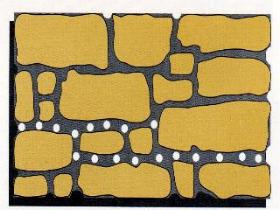

Wacker-Chemie GmbH

GRAVITY FEED
OF THE DAMP PROOFING LIQUID
The second stage is the application of the Ab-Tech siloxane
damp-proofing liquid into the drilled holes using a pump or any
convenient dispensing aid, such as a plastic bottle. The liquid
is applied without any pressure by gravity feed into the holes,
to soak in naturally by capillary action. We recommend the STM
hand pump for 20L cans and a plastic sauce bottle, as the most
convenient aids for DIY.
Calculate the quantity of damp proofing liquid needed for a
target section of wall, according to the "Typical Application Rates" sheet.
For example:
- Single skin brick: 2 - 3 litres/m
- Solid stone walls: 7 - 10 litres/m
Fill the holes in the chosen section in sequence, approximately
the same small amount into each hole to help get a uniform distribution
along the wall. After the liquid has been absorbed, return to
the start and refill in the same sequence. Repeat the refilling
for as many times as necessary, until the calculated quantity
of damp proofing liquid for the target section has been absorbed.
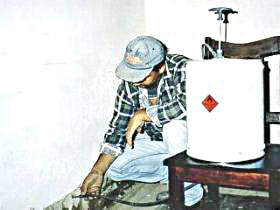
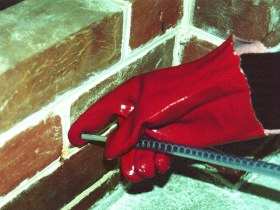
The repeated refilling process may take a few hours or even
longer to complete, depending on the porosity of the wall. The
liquid keeps soaking for several days after application. Do not
attempt to short-cut and use insufficient liquid, otherwise the
whole effort will be wasted.
If the wall is cracked or otherwise damaged the liquid may
drain from some holes on to the ground without being absorbed
into the wall. Avoid refilling these holes. Either drill new holes
that will hold the liquid or apply additional liquid to the adjoining
holes, to obtain complete saturation. Alternatively, a mortar
plug, cotton wool or sponge wadding can be pushed into the problem
holes, to help hold the liquid so it soaks into the wall. If the
liquid stays in the wall, sometimes accumulating in some voids,
it will eventually soak throughout the wall, particularly being
distributed by capillary action in the very porous old lime mortar
in old walls.
After the silicone treatment, patch the holes with matching
mortar or plaster, as appropriate.
Caution: Ab-Tech Damp Proofing Liquid is a petroleum
liquid, with similar safety characteristics to kerosene, requiring
safe handling and storage. Please refer to the Safety Precautions
information on the product can labels. Avoid exposure of the liquid
to water or moist air during handling and storage as this may
prematurely cure the silicone content and make it ineffective
for application.

PLANNING
CHECK LIST
- Measure the length of each wall affected. Calculate
the quantity of siloxane damp-proofing liquid needed for each
type and thickness of wall, using the Application Rates information.
Add up the total quantity of liquid that you will need for the
job. Purchase the liquid. Price list.
- Select the correct drill bit size needed. Use 12mm
diameter or larger drill bits for stone. Use 10mm, 8mm or 6mm
drills for drilling into brickwork, depending on the type of
brick. Refer to the DIY sheet for guidance. Select the correct
drill length for your type of wall. If you need assistance, please
ask us to help you with the selection. If you choose to hire
our drilling machine, you will need to purchase a special drill
bit that fits the machine. Purchase the drill bits needed.
Price list.
- Do you have an adequate drilling machine? For small
jobs a standard hammer drill will do. For larger jobs, a percussion
rotary hammer drill is essential (Ramset, Hilti, etc.) The physical
effort needed and the wear and tear on drill bits will be significantly
less if you use a percussion drill. We hire heavy-duty rotary
hammer drills at cheap rates, for the convenience of our customers.
Hire the drilling machine. Price
list
- We recommend the STM hand pump to dispense the damp-proofing
liquid from the 20L product container into the drilled holes.
A plastic ‘sauce bottle’ is OK for small jobs. Purchase
STM pump. Price list.

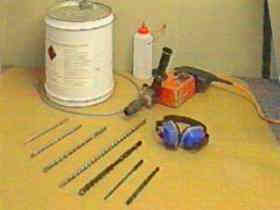

JOB SUMMARY
- Drill holes in the walls needing treatment.
Choose a layer for treatment near the base of the wall. Drill
the holes downwards at an angle to create a reservoir for distributing
the liquid while it soaks into the wall. Refer to the DIY sheet
for guidance. If you need further assistance, please ask us for
advice.
- Vacuum the drilling dust out of the holes.
- Select one or several walls of the same type for a target
batch of work. Measure the aggregate length and calculate
the quantity of damp-proofing liquid needed for this
batch, according to the Application Rates information.
- Fill all the holes with a small quantity of damp-proofing
liquid in the selected batch of walls in sequence. When
the liquid has soaked into the wall, repeat the application dose
of the liquid. Keep repeating the application until
the required quantity for the selected batch has been used.
- Patch up the holes. Use matching mortar in
exposed brickwork or stonework. Use patching plaster for internal
walls. This will complete the silicone damp-course work. If necessary,
arrange for any further building or restoration work needed.
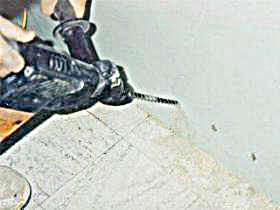

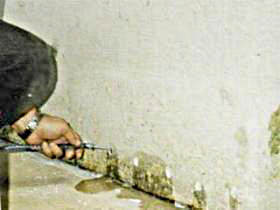
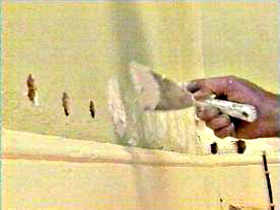

SALT DAMP SHOP,
Adelaide, South Australia
home | videos
| about salt damp | silicone
| do
it yourself















